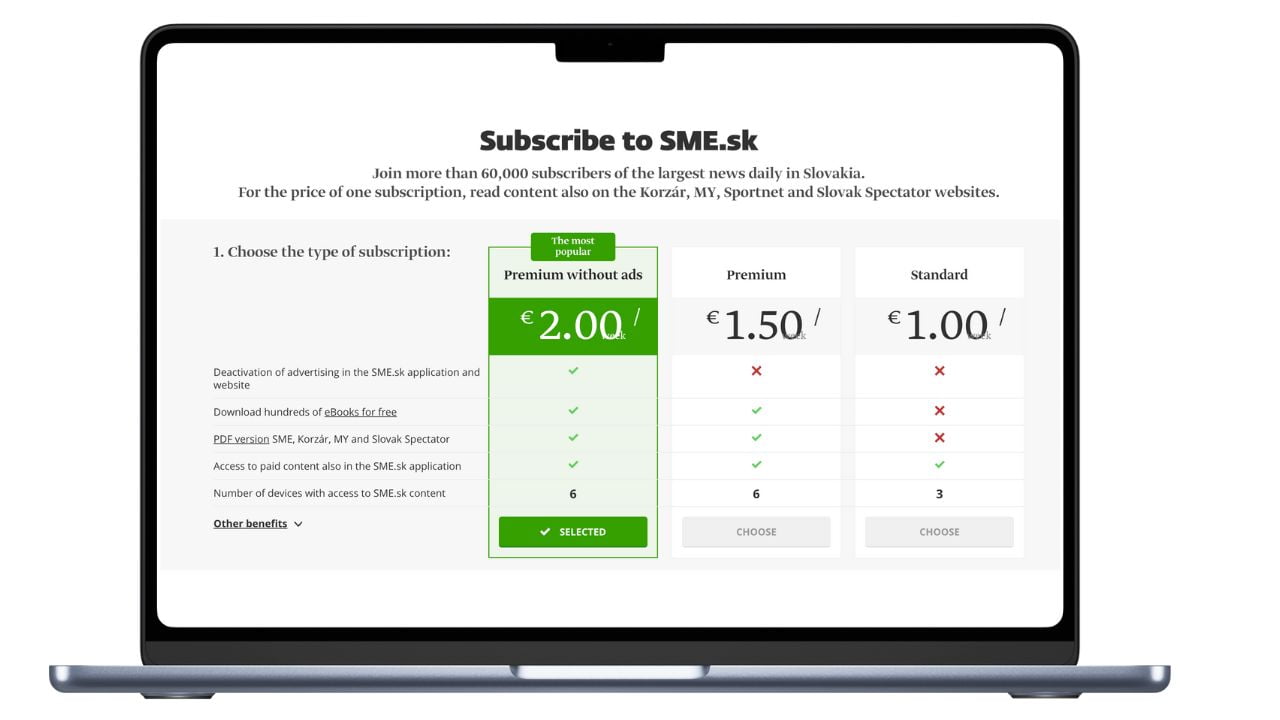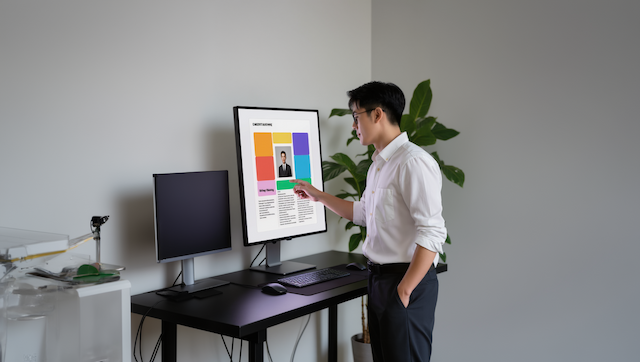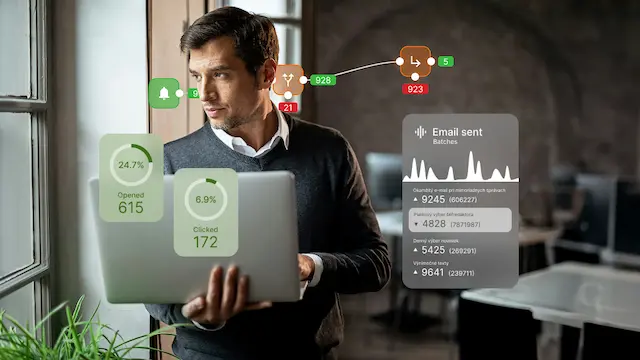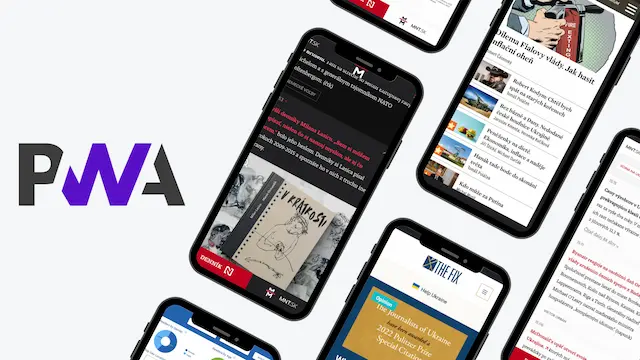Producing top-notch news while selling holiday packages or even pizza? Why not! Petit Press, one of the largest Slovak publishers, is proof that diversifying your online portfolio is a brilliant idea. In this interview with their Board member and CDO, Peter Mačinga, we discuss why it’s important to quit things that don’t work, how to be a profitable publisher, and how to effectively work with subscribers.
Petit Press publishes more than 35 national and regional titles, including the most popular Slovak newspaper SME and its online version SME.sk. SME.sk is read by 2.6 million people every month, which is about half of the Slovak population. Petit Press owns the only printing plant in Slovakia.
How has SME changed since you joined in 2007?
The online business has changed a lot. Initially, we used to do only news reporting, but as our traffic kept growing, we have been experimenting with different ways to monetize our audience. SME now reaches 50-60% of the Slovak online population.
What business models have you tried?
We run two popular portals, restauracie.sk, the largest database of restaurants and daily menus in Slovakia, and dovolenky.sme.sk, a travel agency that arranges tours from dozens of Slovak and foreign agencies. For 10 years, we ran a property portal until we sold it to a competitor. We also ran a discount portal aggregator for a long time but we shut it down last year because it was starting to go down. We also used to deliver pizza for six years and then sold it.
It sounds like you’ve tried things across many industries! This reminds me of a book I’m reading right now called Quit: The Power of Knowing When to Walk Away. It looks like SME is good at determining when to stick to something and when to quit.
Yes, it’s an important life skill. If we want to be profitable, we have to do things that make money. We’ve shut down 15 mini-projects that didn’t make sense from a financial point of view. If it were up to me, I would drop some more, but we’re still keeping them because they have a social impact. For example, the project knihy.sme.sk, which scans old books into digital form.
Over the past two decades, the media landscape has changed tremendously. SME focuses both on print and digital. Is print still a profitable business?
It is, but it has no future because it’s in decline. 90% of people who subscribe to print are retired. That’s why we focus so much on the online site. In 2011, we were among the first publishers in the world to offer digital subscriptions. Until then, the online part of the business lived on advertising alone. Now digital subscriptions make one third of the revenue, and the remaining two thirds come from advertising.
Since 2011, SME.sk has collected more than 60,000 subscribers. Is the number still growing?
No, our subscriber numbers have stopped growing. They’ve been stagnating for two years. We had 62,000, but we currently have 58,000 subscribers.
Why is that? Is the market saturated?
From what we’re seeing in Slovakia, it looks like the market is saturated. We have seen an increase in sales due to higher prices and a different product structure, but the number of customers is not growing. There is a lot of political fatigue in Slovakia, so frustration is contributing to this. People are switching off.
That makes it even more important to stay on top of things, maintain a strong brand and keep subscribers engaged. How can technology support this goal? Which tools do you use for managing subscriptions and what key features do you look for when choosing technology?
We decided to use a system called REMP because we needed an all-in-one solution for managing our subscription system, which would be highly adaptive to our needs. REMP offers a detailed management of subscription products and evidence of accounting and it also helps us manage our internal marketing campaigns on our websites, including email marketing. It allows us to automate many processes, which our employees would otherwise have to do manually.

To remain profitable, we’ve had to diversify our business and embrace technology like REMP, which has allowed us to streamline subscriptions, automate processes, and focus on engaging our audience in a saturated market
Peter Mačinga
What led you to choosing REMP specifically?
The main motivation was price. It’s open source, so it’s free. You only have to pay for hosting. We decided to use Cloud, which is even cheaper than if we had to host it locally at SME. Another reason why we decided to use REMP is because our developers can add new functionalities. For example, they created a local accounting system for our Bratislava office. And lastly, our developers communicate on a weekly basis with developers of REMP, who are also based in Bratislava, so if we have a problem, they can help us.
How big is the SME’s team working on the subscription business?
We have two programmers, one analyst, two people in marketing, a product manager who takes care of adding various features, and also two to three people on the help desk.
How does REMP support SME’s journalists in their daily work?
Our journalists get daily overviews of all articles published, weekly summaries of their own articles, and a list of their best converting articles every month. They follow the article metrics, specifically: conversion rate of the article, the number of new registrations triggered by the article, the number of unique visitors to the article and ratio of visits by subscribers versus non-subscribers.
Do you see any limitations of REMP?
Because we are larger than most customers of REMP and have millions of visitors, we sometimes hit the limits of this software but I’d say that this happens with every software and REMP has definitely more advantages than disadvantages.
Related articles
With SME being one of the pioneers in digital subscriptions, what advice would you give to publishers looking to scale their own subscription models?
Make sure you find the right ratio between locked and free content and monitor closely how it impacts advertising. We’ve experimented with different ratios, from locking all content to locking 20% of content. When we tried locking all content, it had a very negative impact on advertising and we started to lose money. What works best for us is the 50:50 model. This means that roughly half of the articles are free (mostly agency articles) and half are locked (mostly authored texts from our journalists).
How many people are willing to pay for locked content?
It’s not very high in Slovakia. If you check the Digital News Report 2024 by Reuters Institute and University of Oxford, you’ll see that it’s much higher in the Nordic countries. For example, 40% of people in Norway and 31% of people in Sweden are willing to pay for content. In Slovakia, more than 90% of people are NOT willing to pay for content, so you have to monetize them in other ways — and we’re doing our best.
What helps you retain current readers and gain new ones?
We got inspired by Amazon Prime Day and once per year, on our anniversary, we offer subscribers a discount. That’s when we get the most subscribers. We offer three types of subscriptions: standard, premium and premium without advertising for 31 € for different periods, annual, seven-month and nine-month. It’s been working quite well for us.
Who inspires or influences your pricing policy?
Surprisingly, no one from the publishers’ world. I honestly like the approach of Netflix. There is one price for the whole market. If you want it, you can have it. If you don’t want it, turn it off.
Do you also offer subscriptions to your podcasts?
We have a hybrid model where all our podcasts are free on all platforms but some content is only available to subscribers on the Toldo app. We are constantly trying to experiment.
And lastly, what other digital initiatives are you currently working on?
We are developing an in-house CMS system for medium and large publishers who have millions of readers and millions of articles. We would like to make it open-source and are looking for other publishers who want to cooperate on this.
Subscribe to our newsletter and get more inspiring interviews directly in your inbox.
Enjoyed the post? Share it.
A growth strategist passionate about helping publishers boost their revenue.












